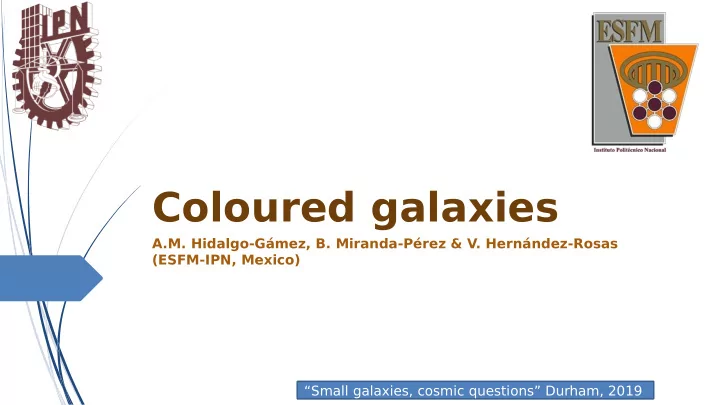

Coloured galaxies A.M. Hidalgo-Gámez, B. Miranda-Pérez & V. Hernández-Rosas (ESFM-IPN, Mexico) “Small galaxies, cosmic questions” Durham, 2019
There are only 7 SHARDS galaxies with EW([OIII]) between 200 Å and 280 Å (Lumbreras-Calle, private communication). A sample of 34 regions in WR galaxies (López- Sánchez & Esteban 2010), 66 Im, 51 starburst, 72 BCD’s and 30 hot spots in galaxies (Kniazev et al. 2004)
-Equivalent width of the oxygen line [OIII]λ5007 larger than 200Å -Compact size, smaller than 4” for nearby and 2” for distant galaxies -not very far galaxies Unsual composite gri colour: Green, purple or brigth blue Sample: 87 galaxies Besides, these galaxies have EW([OIII])/EW(Hα) larger than 1
z EW([OIII]) r (kpc) Mu Mg Mr Mi Mz Green 0.25 813 11.9 -19.4 -20.6 -20.8 -20.13 -20.5 Purple 0.09 609 6.0 -18.9 -19.5 -19.3 -19.7 -19.5 blue 0.027 689 1.6 -17.3 -18.1 -17.7 -17.5 -17.6 Miranda-Pérez, 2017, Master thesis
Actually, only about of 1/4 of our sample have been classified as green peas (Cardamone et al. 2009) or blueberry galaxies (Yang et al. 2017).
Why the EW([OIII]) is so large? -AGN embeded -Starburst All the galaxies are in the Star-forming region, although at the very high excitation end.
Are the coloured galaxies starbursts? We determined the SFR from the UV luminosity using images from GALEX. The sky brackground subtraction as well as the flux measurements were obtained by us. The fluxes were extinction (galactic and internal) corrected and Kennicutt’s equation were used to determined the SFR (Hernández- Rosas, Master thesis, 2019).
According to Melbourne et al. (2005) the SFR is larger than 2 M◦/yr. According to Heckman (2005) the density of SFR should be larger than 10 M◦/ yr kpc2.
We determined the chemical abundance of the galaxies in the sample from the SDSS spectra (standard method), measuring the intensity of the lines with ALICE-MIDAS, correcting from absorption and extinction (Hidalgo-Gàmez & Miranda-Pèrez 2018; Miranda-Pérez & Hidalgo-Gámez, in preparation). GP (Hawley Green Purple Blue 2012) 8.11 12+log(O/H) 8.00 8.1 8.0 6.86 12+log(N/H) 6.44 6.36 6.18 -1.25 log(N/O) -1.55 -1.69 -1.79 7.43 12+log(Ne/H) 7.05 7.16 7.07 -0.68 log(Ne/O) -0.95 -0.95 -0.93 6.83 12+log(S/H) 6.82 6.53 6.38 -1.25 log(S/O) -1.40 -1.54 -1.67 - 12+log(Ar/H) 5.7 5.8 5.64 - log(Ar/H) -2.38 -2.3 -2.37
This is not in agreement with the age of the bursts, determined from the EW(Hβ), the oxygen abundance and the EW([OIII]), using the classical models by Coppetti et al. (1986).
Conclusions We still don’t know why EW([OIII]) is so large! These coloured galaxies resemble “green peas” but most of them are not classified as them. They also resemble BCD. The SFR varies from 23.8 to 0.02 M/yr, being the green galaxies those with the large values and the blue ones those with the smallest. Only 1/3 (at best!) of the sample might been suffering a big event of star formation. However, the spectral characteristics are very similar between them. There is not differences in the chemical abundances between the galaxies despite the different redshift. There is no real evolution on any of the spectral parameters.
Recommend
More recommend